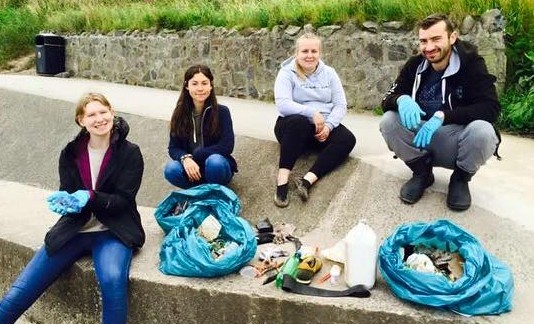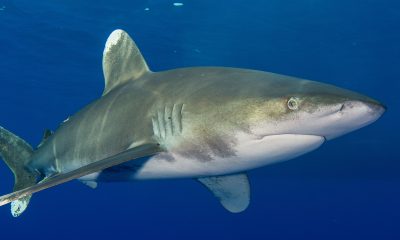News
The ocean is suffering – here’s how you can help

The oceans are suffering. Around 8 million items of litter enter the marine environment every day; plastic is now the most common element found in the ocean. One hundred thousand sea mammals are killed in the ocean by pollution each year, and another three hundred thousand dolphins and porpoises die each year because of becoming entangled in ghost fishing gear.
Stopping pollution and removing pollution from the ocean is a momentous task. But everything begins with small steps; some can be done from the comfort of your own home, and some can be integrated into the classic bank holiday trip to the seaside.
Some ocean friendly choices are:
Use bags for life instead of normal plastic bags
A plastic bag can take between 150 years to over 1,000 years before it degrades. However, it doesn’t biodegrade, it’s broken down by light into tiny little fragments of plastic, which are toxic – these are known as microplastics. In relation to the ocean, an estimated 1,000,000 birds, 100,000 turtles, and countless other sea organisms die each year from ingesting plastic, according to Greenpeace. They can easily mistake plastic bags for jellyfish and other edible sea creatures. Using a reusable carrier bag prevents more plastic entering our oceans.
Join a beach clean
Bank holidays are always an excuse to visit the seaside – have some chips sat on the pier, watch the kids fight over who has built the best sandcastle… or you could join one of the many groups of people who spend their weekends/bank holidays cleaning the beaches. They collect washed up cans, plastic bottles, toys… all sorts of things! There are events organised all over the UK for people to take part in (here, here, here). Or you could organise you own! Maybe have an impromptu tidy up, making it a game for the children. To see some of the amazing things which have been found on beach cleans look here.
Recycle
Recycling 14 trees worth of paper reduces air pollutants by 165,142 tons. I know we’re discussing marine pollution, but ocean acidification is caused by the uptake of CO2 from the air, and recycling could potentially slow the rate of coral bleaching and save calcified organisms, which are damaged by increasing ocean acidity.
The dumping of used plastic destroys sea life at an estimated 1,000,000 sea creatures per year! Glass and plastic take the longest to degrade, but are completely recyclable, which is why it’s important we recycle them. It’s believed that 60%-70% of rubbish we put in our bins could have been recycled instead. Recycling doesn’t just reduce the amount of waste entering the ocean, it also reduces the amount of power we use. Theoretically, we could hit two birds with one stone. When we produce aluminium products from virgin metal it consumes close to 100 times the power required to recycle aluminium. In the UK an estimated 70% of our energy comes from non-renewable energy sources. If we use less energy we will lower the amount of air pollution, which I’ve already mentioned has horrific effects for our oceans.
Food scraps to compost
In 2009 it was found that an estimated 25% of food bought by households was thrown away. Food waste contains Nitrogen and Phosphorous which when in water can lead to eutrophication and algae blooms.
By collecting your food waste and using it to produce compost you are reducing your rubbish – and that compost can be used instead of artificial fertilizers.
Compost is great for the environment and great for you. It’s free to make and replaces somewhat expensive fertilizer and shop bought compost.
To find out how to set up your own compost look at my previous article here.
Purchase items with minimum packaging
When you go into a supermarket, it’s likely you will see more packaging that you will food. I know I do! Apples surrounded in Styrofoam holders swarming with plastic wrapping, bread suffocating in plastic bags…
To reduce your waste and plastic usage try and purchase items which come with less packaging, or at least recyclable packaging. Most plastic can be recycled, but make sure you read the packaging, and look for the recyclable symbol. Styrofoam is not recyclable and can take over 500 years before it typically begins to break down. In the ocean, Styrofoam is often mistaken for food and eaten; when inside an organism, it blocks the digestive tract and the organism will usually starve and then die.
Read the label
I will admit I am terrible for looking at labels when I’m shopping, but I try and check for the basics: sustainable fishing (the blue tick – if you want more information about how to shop for fish sustainably there is information here). I also avoid microbead products. Although they are now being phased out (UK and USA), it will still take years before they are completely gone from our shelves. A new one I will be adding to my list is cleaning products which contain phosphate which can lead to eutrophication (excessive richness of nutrients) and algal blooms (rapid growth of algae, which can cause oxygen reduction). A small change in your shopping habits can make a big difference to the ocean; for example, allowing fish stocks to increase.

Sustainably caught Pollack. Credit John Wheeler
On a positive note, we are making a difference – we are increasing the amount of power we receive from renewable sources; we are also reducing the amount of plastic we use. We’re moving forwards to a brighter future – one with a healthier ocean.
I hope these tips have given you a few ideas to help you lead a greener life, and to know that no matter how far away from the coast you are, you matter to it.
Gear News
Scubapro Free Octopus Promotion 2024

Free Octopus with every purchase of a SCUBAPRO regulator system
Just in time for the spring season, divers can save money with the FREE OCTOPUS SPRING PROMOTION! Until July 31st SCUBAPRO offers an Octopus for free
with every purchase of a regulator system!
Get a free S270 OCTOPUS with purchase of these combinations:
MK25 EVO or MK19 EVO with A700
MK25 EVO or MK19 EVO with S620Ti
MK25 EVO or MK19 EVO with D420
MK25 EVO Din mit S620Ti-X
Get a free R105 OCTOPUS with purchase of the following combinations:
MK25 EVO or MK19 EVO with G260
MK25 EVO or MK17 EVO with S600
SCUBAPRO offers a 30-year first owner warranty on all regulators, with a revision period of two years or 100 dives. All SCUBAPRO regulators are of course certified according to the new European test standard EN250-2014.
Available at participating SCUBAPRO dealers. Promotion may not be available in all regions. Find an authorized SCUBAPRO Dealer at scubapro.com.
More information available on www.scubapro.com.
Blogs
Northern Red Sea Reefs and Wrecks Trip Report, Part 3: The Mighty Thistlegorm

Jake Davies boards Ghazala Explorer for an unforgettable Red Sea diving experience…
Overnight, the wind picked up, making the planned morning dive a bit bumpy on the Zodiacs to the drop point on Thomas Reef. There, we would dive along the reef before descending through the canyon and then passing under the arch before ascending the wall with a gentle drift. The site provided great encounters with more pelagic species, including shoals of large barracuda, tuna, and bigeye trevally.
Once back on the boat, it was time to get everything tied down again as we would head back south. This time, with the wind behind us, heading to Ras Mohammed to dive Jackfish Alley for another great gentle drift wall dive before then heading up the coast towards the Gulf of Suez to moor up at the wreck of the Thistlegorm. This being the highlight wreck dive of the trip and for many onboard, including myself, it was the first time diving this iconic wreck. I had heard so much about the wreck from friends, and globally, this is a must on any diver’s list. Fortunately for us, there was only one other boat at the site, which was a rarity. A great briefing was delivered by Ahmed, who provided a detailed background about the wreck’s history along with all the required safety information as the currents and visibility at the site can be variable.

Kitting up, there was a lot of excitement on deck before entering the water and heading down the shoreline. Descending to the wreck, there was a light northerly current which reduced the visibility, making it feel more like the conditions that can be found off the Welsh coast. At 10m from the bottom, the outline of the wreck appeared as we reached the area of the wreck which had been bombed, as our mooring line was attached to part of the propeller shaft. Arriving on deck, instantly everywhere you looked there were many of the supplies which the ship was carrying, including Bren Carrier tanks and projectiles that instantly stood out.

We headed around the exterior, taking a look at the large propeller and guns mounted on deck before entering the wreck on the port side to take a look in the holds. It was incredible to see all the trucks, Norton 16H, and BSA motorcycles still perfectly stacked within, providing a real snapshot in time.

Overall, we had four dives on the Thistlegorm, where for all of the dives we were the only group in the water, and at times, there were just three of us on the whole wreck, which made it even more special, especially knowing that most days the wreck has hundreds of divers. Along with the history of the wreck, there was plenty of marine life on the wreck and around, from big green turtles to batfish, along with shoals of mackerel being hunted by trevally. Some unforgettable dives.

The final leg of the trip saw us cross back over the Suez Canal to the Gobal Islands where we planned to stay the night and do three dives at the Dolphin House for the potential of sharing the dive with dolphins. The site, which included a channel that was teeming with reef fish, especially large numbers of goatfish that swam in large shoals along the edge of the reef. These were nice relaxing dives to end the week. Unfortunately, the dolphins didn’t show up, which was okay as like all marine life they are difficult to predict and you can’t guarantee what’s going to be seen. With the last dive complete, we headed back to port for the final night where it was time to clean all the kit and pack before the departure flight the next day.

The whole week from start to finish on Ghazala Explorer was amazing; the boat had all the facilities you need for a comfortable week aboard. The crew were always there to help throughout the day and the chefs providing top quality food which was required after every dive. The itinerary providing some of the best diving with a nice mixture of wreck and reef dives. I would recommend the trip to anyone, whether it’s your first Red Sea liveaboard in the Red Sea or you’re revisiting. Hopefully, it’s not too long before I head back to explore more of the Red Sea onboard Ghazala Explorer.

To find out more about the Northern Red Sea reef and wrecks itineraries aboard Ghazala Explorer, or to book, contact Scuba Travel now:
Email: dive@scubatravel.com
Tel: +44 (0)1483 411590
Photos: Jake Davies / Avalon.Red
-

 News3 months ago
News3 months agoHone your underwater photography skills with Alphamarine Photography at Red Sea Diving Safari in March
-

 News3 months ago
News3 months agoCapturing Critters in Lembeh Underwater Photography Workshop 2024: Event Roundup
-

 Marine Life & Conservation Blogs2 months ago
Marine Life & Conservation Blogs2 months agoCreature Feature: Swell Sharks
-

 Blogs2 months ago
Blogs2 months agoMurex Resorts: Passport to Paradise!
-

 Blogs2 months ago
Blogs2 months agoDiver Discovering Whale Skeletons Beneath Ice Judged World’s Best Underwater Photograph
-

 Gear Reviews3 months ago
Gear Reviews3 months agoGear Review: Oceanic+ Dive Housing for iPhone
-

 Marine Life & Conservation2 months ago
Marine Life & Conservation2 months agoSave the Manatee Club launches brand new webcams at Silver Springs State Park, Florida
-

 News3 months ago
News3 months agoWorld’s Best Underwater Photographers Unveil Breathtaking Images at World Shootout 2023
















